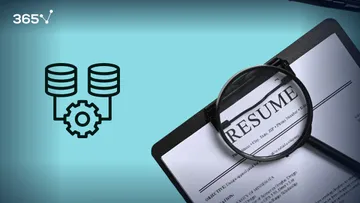Recruiters go through hundreds of applications daily, so writing a data science resume that makes an impression is challenging.
Large enterprises like Google receive more than two million applications a year. Nearly all prominent corporations—including over 98% of the Fortune 500—use Applicant Tracking Systems (ATS). That’s one more barrier your resume needs to jump.
So, how do you write a captivating resume that will land you a data science job interview?
You’ll learn everything you need in this article. Feel free to jump to the sections that are relevant to you.
The Complete Data Science Resume Guide in 2025: Table of Contents
- Data Science Resume Best Practices
- Types of Resumes for Different Experience Levels
- Entry-Level Data Science Resume
- Data Science Resume for Career Switchers
- Senior Data Scientist Resume
- Do’s and Don’ts in a Data Science Resume
- Resume vs CV
- Should You Use Professional Resume-Writing Services?
- The Best Resume Builder Websites and Resources
- How to Build Your Digital Presence
- The Data Science Resume Writing Process
1. Data Science Resume Best Practices
Regardless of your experience, background, and goals, there are universal rules to follow when creating a resume.
Tailor Your Resume to the Job Offer
For starters, forget the generic resume——tailor it to the position and company you’re applying for. Your resume must meet the employer’s expectations and demonstrate that you’re a data science professional with the right mindset, qualifications, and skills for the job. A successful data science resume contains keywords matching the skills and competencies listed in the job description.
Use Numbers and Metrics
Recruiters seek experience, a specific degree, and skills that match the description. Simply listing your competencies isn’t enough. You must back them up with numbers and details that highlight and add credibility to your accomplishments.
Use Strong Action Verbs
Strong action verbs demonstrate you’re a doer and achiever. For example, instead of being "responsible for data analysis," write that you "executed the (X/Y) data analysis project." To make your achievement even more convincing, add the project outcome: "Executed a customer churn analysis project that led to a 15% increase in retention rates." Format Your Resume Professionally
Once you’ve covered the essentials, you should fine-tune your data science resume to add a professional touch.
Don’t underestimate the power of a consistent, pleasing-to-the-eye format and a clean look. Your data science resume must be appealing, concise, easy to read, and mistake-free.
And make it brief. Employers love a concise resume highlighting the qualifications, skills, and experience needed.
2. Types of Resumes for Different Experience Levels
The sections, outline, writing style, and format of your resume may vary depending on where you are on your data science career path.
The following section is dedicated to those new to data science, especially recent college graduates and professionals transitioning from another field.
We’ll then continue with valuable insights for those with rich experience who wish to move up the data science career ladder or switch employers.
Types of Resumes
- Skills-based/functional resumes focus more on your capabilities and achievements and less on your work experience. It’s preferred for junior professionals, career switchers, and college students at the beginning of their data science career journey.
- Chronological resumes are work experience-oriented. This is the best option for professionals who have held multiple related positions. If you're a recent graduate who doesn't have years on the job, a chronological data scientist resume will only bring attention to this weakness.
- Combination/hybrid resumes are ideal for career switchers and candidates with relevant work experience. It combines elements of the other two formats, allowing you to emphasize your capabilities and experience equally. Even if you haven’t worked as a data scientist, this enables you to showcase your transferrable skills.
There’s no right type of resume. Choose the one that highlights your competencies in the best way.
3. Entry-Level Data Science Resume
This section is devoted to those who have just graduated from college or university and wish to start building a data science career. Discover what you need to craft a resume that will get you a job interview for your first entry-level data science position.
Once you achieve this, we’ll help you prepare for your data science interview.
How to Write a Skills-Based Resume
Write down your relevant experience, including education, internships, job-specific skills, and data science projects. Once you list everything that comes to mind, start organizing the content. Don’t initially become preoccupied with consistent formatting or details when creating an entry-level data science resume.
Resume Sections
A functional data scientist resume typically has an extensive skills section, including a list of your capabilities with a brief description of how you’ve obtained and applied them. The rest depends on your experience—you can list previous jobs, volunteer work, relevant projects, education, languages, interests, etc. Adding a summary is also a good idea.
When organizing your resume, put your skills and achievements first, then continue with data science projects you’ve worked on, and finally, include your relevant employment history and education.
The sections’ order, however, is not set in stone. Tailor the data science resume to your experience and the job requirements. For example, the astrophysics club may not be relevant to the data analyst position in a financial corporation, but it could be a great asset for a software engineer internship.
Resume Headline
Your name should be the first item on the page, followed by a headline briefly describing your experience, education, current job title, and areas of interest. Although the headline represents you, ensure it applies to the job you’re applying for. Keep it short and relevant—a few words or a short sentence fragment are more than enough. Contact Information
The next element on your data science resume should be your contact details, which include your full name, phone number, and professional email address. You can also add links to your LinkedIn, GitHub, Kaggle profile, or other platforms that demonstrate your data science adeptness.
Data Science Resume Objective vs Profile Summary
A data scientist resume can contain an objective or a profile summary section. While the two are similar and sometimes used interchangeably, some key differences exist.
The objective statement is slightly shorter and closely related to the position you’re applying for. It highlights your professional goals and how you would contribute to your desired position and company.
In contrast, the summary focuses on your qualifications. It emphasizes the skills, experience, and achievements that make you a good fit for the job.
These are optional sections, so if you include one, ensure it’s worth the space. Tailor them to the company and position, mirror the language of the job posting, and highlight your most significant strengths.
Although some claim that the objective statement is outdated, if you’re applying for an entry-level job or internship, your data science resume may benefit from such a section.
Objective Statement Examples
- Result-oriented individual with a strong capacity for learning and a bachelor’s in computer science. Seeking to utilize hands-on modeling experience as an entry-level data scientist at BCG Gamma. Possessing expert knowledge of scripting languages and the ability to work in a cross-functional environment.
- A highly analytical economics graduate with strong interpersonal and leadership skills. Possessing a solid statistics background, programming skills, and ability to communicate complex and industry-specific concepts. Looking to apply superior analytics skills as a data analyst at IBM.
- Seeking to gain model development experience and a strong understanding of research design and hypothesis testing as a data scientist at Appsilon Data Science. Providing programming skills and the ability to analyze complex data. A team player with strong communication skills and data science certification.
Education
The education section may appear earlier in your data science resume if you’re an aspiring data science professional who has just finished college. If you’ve graduated with one of the most in-demand degrees for data scientists, you can add it below the contact information or the objective section.
State the name of the college or university, city, state, and degree (data science, statistics, computer science, engineering, etc.). Include your major(s) and minor(s) and the year and month you completed your degree (or expected date of completion). List the highest or most relevant first if you have more than one degree. US graduates can also include their GPA score (optional).
Data Science Projects and Publications
How do you include project details in your resume? This section allows you to compensate for the absence of rich professional experience. You can include significant data science-related coursework and academic projects you’ve completed.
But more importantly, showcase any side projects you’ve worked on to demonstrate initiative and ability to work independently. Add links to GitHub projects in your data scientist resume so potential employers can see what you’ve created and how you’ve done it.
Experience
It’s natural to feel anxious if you lack relevant work experience. But there are meaningful ways to fill in this section and plenty of entry-level positions that don’t require years on the job. You can include clubs and societies you’ve actively participated in, internships, academic research, volunteer work, etc.
Choose relevant headings for the listed experiences and add the most relevant ones first. Format them as you would with any work experience—including the name and location of the organization, your role or title, and the period of your work. Add two to five bullet points per experience demonstrating how you applied your skills to the assignment or a project.
Skills
This is the most essential part of the functional data science resume. How do you stand out without years of experience? Employers are seeking transferable skills in fresh-out-of-college applicants for entry-level data science positions.
Transferable skills indicate you have what it takes to succeed in a given role. Many of the skills required for data science positions are universal:
- A sharp eye for detail
- Leadership
- Identifying issues and developing effective solutions
- Understanding and confidently presenting technical information to non-technical audiences
- Initiative and ability to learn quickly and work efficiently
- Planning, organizing, and managing multiple projects with competing demands and deadlines
- Being a team player and interacting with employees of all levels of the organization
List all relevant skills to the position and illustrate how you’ve applied them.
Honors and Awards
Honors and awards can also be a stand-alone section on your data science resume. List the name of each honor or award and the date you received it. A brief description emphasizing your accomplishment is optional.
Certificates
Adding data science certificates provides additional credibility to your resume, proving you’re qualified for the position—even if you don’t have much relevant experience. They also demonstrate ambition and commitment to developing industry-relevant and in-demand data science skills.
Updating your data science resume with newly acquired certificates is good practice. If you don’t have a certificate, consider signing up for a data science training program, upgrading your skillset with the specific position in mind.
Volunteer Activities and Community Involvement (Optional)
You can showcase your participation in various on- and off-campus communities. Include the positions you’ve been appointed to, the organizations’ names, locations, and dates. In addition, you can highlight a ‘study abroad’ program you’ve been enrolled in and prominent volunteer experience.
Interests (Optional)
Interests is an optional section. Many employers would like to know more about you outside of your education and job-related experience. This helps them determine what kind of person you are and whether you’d fit the company culture.
But this section should be your last priority. Include it only if your interests are relevant to the position or organization. Be genuine but keep it professional.
Data Science Resume Writing Style
You should follow a few style guidelines to write an impressive resume. First, keep in mind that this is your first introduction to a prospective employer. So, take your time to make it visually appealing and error-free.
Second, be brief and concise. Include only relevant information to the data science position that underscores your qualifications. Don’t overload it. Your resume may get only 15 to 30 seconds of consideration.
Your resume should be:
- Straightforward and comprehensive
- Clear and concise
- Professional and grammatically correct
- Factual and accurately describing your accomplishments
- Written with action verbs
A good data scientist resume utilizes a good dose of power verbs. Refer to this list of action verbs for inspiration.
Now that you know how to write an engaging resume, let’s discuss formatting.
How to Format Your Data Science Resume
After spending long hours writing your resume, the last thing you want is for it to end up in the rejection pile. So, what should it look like to make a good first impression?
Adequate spacing, proper alignment, and neatly organized content are mandatory. And make sure everything fits onto one page.
But how do you create an appealing format?
There are plenty of options online. Most candidates use standard one-page templates. You can download our simple yet stylish data science resume sample and fill in your information.
You could also select a more elaborate format for your data scientist resume. But consider the type of job you’re applying for. Don’t go overboard with a flashy resume design and intricate elements.
And if you wish to design your resume from scratch, follow these formatting tips.
Resume Header
Section headings should be left-aligned and prominent but not distracting. You can bold or capitalize, use italics, or underline them—breaking up the document length and creating emphasis. And remember to be consistent. Stick to the same formatting for identical pieces of content—e.g., bold for the organizations you’ve worked for, italics for the job titles, and so on.
Font
Your data science resume must be easy to read.
So, choose a font size between 10.5 and 12. The only part that should be larger is your name at the top. If your text is size 12, use 14 or 16 for your name.
Choose a font that’s easy to read on- and off-screen. It’s a means to deliver your message, so it shouldn’t be distracting.
Resume Length
The standard resume length is one page, especially for recent graduates and young professionals. You may need two pages if you have a significant amount of relevant experience, advanced degrees, or publications.
But mind that recruiters typically spend only seconds per resume. Anything longer than one page may discourage them from reading it. So, it’s better to narrow it to the crucial information and save the rest for the interview.
Layout
Your data science resume should be easy to scan. So, use appropriate margin size, sufficient spacing, proper alignment, and bullet points.
Should You Include a Photo in Your Data Science Resume?
The requirements to add a photo to your resume vary depending on the country.
While the UK, Ireland, Canada, Australia, and the US don’t require a pic, it’s highly recommended in most European countries, including Austria, Belgium, France, Germany, Portugal, and Spain, as well as the Scandinavian countries, the Middle East, Africa, Asia, and South America.
4. Data Science Resume for Career Switchers
As an experienced professional, you’ve already sent many resumes throughout your career. But what if your work history has nothing to do with data science, and you wish to transition into the field?
What’s the best type of resume, skills-based, chronological, or combined?
If you switch to data science from a different industry, a chronological resume will make you look like the wrong person for the job. A combined resume is your best option.
Sure, the skills-based data scientist resume is designed for those who don’t have relevant work experience. But you don’t want to divert the spotlight from your work history completely.
With a combined resume, you can demonstrate the transferable skills you’ve gained through your previous experience.
How to Write a Combined Resume
The key to writing a winning data science resume for career switchers is to tailor it to the job requirements. Instead of focusing on your previous experience, employ the mirroring technique by taking all the keywords and phrases used in the job ad to describe the ideal candidate and integrating them into your resume.
You can further align your skills and career aspirations with the company’s goals and needs. (You can find them in the company’s mission statement.)
Now, let’s go over the essential resume sections.
Resume Headline
Your headline must match the role. If you don’t have experience in a similar position, use your desired role as a headline—e.g., Aspiring Data Scientist. This will grab the hiring manager’s attention and help you pass the Applicant Tracking System’s (ATS) scan.
Contact Information
This is straightforward: Add your name, phone number, professional email address, and links to your LinkedIn, GitHub, and Kaggle profiles.
Data Scientist Objective Statement or Summary
The summary focuses on the individual’s experience and qualifications. And while that’s crucial, an objective statement might be more suitable for a career switcher’s resume.
The objective must convey enthusiasm and be tailored to the specific data science position. It also showcases your strengths and capabilities but focuses on how you’ll bring value to the organization.
Skills
This is the most crucial section in your data science resume. To make it work in your favor, determine the relevant skills for the position.
All job postings include keywords describing the top skills employers look for. And your resume will probably be rejected if it doesn’t contain any of them.
Many employers utilize Applicant Tracking Systems (ATS) that scan resumes for keywords and automatically eliminate those that don’t contain them. Hiring managers also look for words and phrases that match the job requirements.
All required skills have already been communicated in the job posting. You just need to use them in your resume.
Carefully evaluate your level of expertise in each area. Select three to five essential skills you feel the most confident in and list them in your data science resume. Then, provide relevant, quantifiable evidence of how you’ve obtained and applied them.
Forget the age-old clichés like trustworthy, dynamic, a problem-solver, great communicator, etc. They seem meaningless unless you also write how you’ve demonstrated those skills and how they apply to your desired job.
Remember that organizations are goal-oriented. List the qualities and skills that translate easily across various industries and contexts and use them to show the value you can provide.
Work Experience
In this section of your data science resume, you can add your previous positions like you would for any application, including the dates, job titles, and company names. But instead of listing the tasks you’ve performed, emphasize the transferable skills you’ve gained.
Quantify the experiences to convey the scale of the projects you’ve worked on and your achievements, making a stronger impression. Include the following instances:
- Established new strategies or procedures
- Used resources effectively (e.g., reduced expenses)
- Demonstrated effective project leadership or management
- Managed or supervised others efficiently
- Received promotions and expanded my scope of responsibilities
- Increased profits and improved the company’s services
And be prepared to answer many follow-up questions for these achievements during the data science interview.
Consider the advice of Edouard Harris—a physicist turned successful data scientist and co-founder at SharpestMinds:
If you’ve worked in finance, leverage your knowledge in finance. Don’t erase your past. Don’t say, “Oh, I was in finance but not anymore.” No, no, no. You want to be like, “Yeah, I was in finance. I was goddamn good at it, and I worked on x, y, and z when I was in finance. And now, look at how I’m applying x, y, and z in interesting and clever ways as appointed to this instance.” You want to tell a story and create a narrative about yourself. And the narrative you create about yourself when you transition isn’t, “Oh, I’m changing everything about myself.” It’s more like, “No. I’m moving away to even further increase the value of the experience that I already have.”
Relevant Certificates/Education
The competition for data science positions is intense. That’s why you need proof that you have the necessary skills for the job. But returning to university to earn a relevant degree could be quite challenging for a working professional, even if you’re in-between jobs.
Fortunately, alternative ways exist to learn data science at your pace. 365 Data Science’s program covers everything you need to become a certified data scientist—from the fundamentals to advanced topics. And adding a certificate of achievement will give your data scientist resume credibility.
Of course, you should add your education, which is still valuable even if it isn’t in a related field.
Data Science Projects and Publications
Next, add all the data science projects you’ve participated in, showcasing your technical skills. Describe the tools and techniques you used and the projects’ outcomes. But don’t overcrowd the section with technical terms. After all, it should be accessible to hiring managers with a non-technical background.
Make this section of your data science resume brief but rich in content. Don’t cover the project in detail; you’ll have the opportunity to discuss it during the interview. Focus on your contribution and achievements.
Honors and Awards (Optional)
Add this section only if your accomplishments are relevant to the position you’re applying for or if they highlight skills that are invaluable to the employer.
Data Scientist Resume Writing Style
Use powerful, action words to make your resume impactful—e.g., instead of “responsible for,” use “managed.” The former doesn’t reveal your involvement in the task or project, depriving you of any credit. In contrast, “managed” conveys you possess leadership skills.
Back this up with numbers, facts, concrete outcomes, and achievements to increase the desired effect. For instance, writing that you managed a project that led to a 47% increase in profits demonstrates that your leadership results in profit growth, and you get well-deserved credit for that.
Of course, keep everything moderate and be realistic and truthful about your achievements. More importantly, include only things you feel confident discussing during the interview.
5. Senior Data Scientist Resume
If you’re a data science professional who wants to climb the ladder, your resume will look different from that of an intern or junior specialist. It’ll also vary depending on whether you want to start a job at a new company or if you’re applying to your current one.
If you wish to switch positions at your current workplace, it’s crucial to highlight all your contributions to the company.
Emphasize your achievements, the issues you’ve resolved, and the projects you’ve participated in. But through all this, highlight how you’ve obtained and applied the skills necessary for the new role. Otherwise, you risk getting in the “you’re too valuable in your current positions” pile.
If you wish to land a job at a new company, highlight your achievements throughout your career.
Make your data science resume focused and concise. This can be difficult if you have vast experience but try to narrow it down to only the most relevant roles and achievements to the new position.
In both cases, you should aim to craft a resume demonstrating your suitability for the role. Emphasize how you’ve obtained and applied the required skills. Include quantitative evidence of your achievements to illustrate your value to your future employer. For instance, state by what percentage you made a process more efficient, how much revenue you helped generate, etc.
The recruiter may ask you to elaborate on your accomplishments during the data science interview. So, be prepared to back your claims by explaining the situation, actions, outcomes, and how you achieved them.
Which data science resume type is suitable to achieve this?
How to Write a Chronological Resume
The most suitable format for a professional with extensive experience is the chronological resume. It lets you focus on the gained experience and creates a narrative of your career progression.
But it may not be the best option if you have long periods of unemployment or have changed your field of work. A combined or skills-based data science resume is more appropriate in these cases.
Sections
The most vital section in the chronological resume is work experience, which you list chronologically—typically from the latest to the oldest position.
Header and Contact Information
If you’re a seasoned data science professional with much to add to your resume, you can skip the summary or objective statement. The summary, however, will add value to your resume. Of course, start with your name, header, and contact information.
Data Science Resume Objective or Summary?
The objective statement aims to demonstrate how your career aspirations meet the employer’s requirements. But a senior professional’s career goals typically become evident from their experience, which makes the objective obsolete.
A summary allows you to create a narrative about your expertise. You can highlight your most valuable qualifications and achievements and give recruiters an idea of your capabilities.
As previously stated, boost your data science resume using the keywords mentioned in the job description, making your resume ATS-friendly. Identify the sought-after skills, select the ones you feel the most confident about, and highlight them in your summary.
You can also go a step further and analyze your target industry and company. Identify your key selling points and tie them to the company issues you’re qualified to solve. Find where your goals meet your target organization's needs and use this to your advantage.
Skills
Unlike the skills-based data scientist resume, the chronological one doesn’t need an extensive skills section with bullet points and long descriptions.
Still, it’s a good idea to list the tools and techniques you feel most confident about, especially the ones mentioned in the job description. Of course, you should be able to demonstrate how you’ve mastered them—e.g., via your experience or certification programs.
Work Experience
This is the largest and most important section in your chronological data scientist resume. There is the challenge of trying to fit everything onto one page. But it’s better to omit some of your previous jobs than to have a lengthy resume that no one wants to read.
So, start with your most recent job, then list your previous roles chronologically. If the list is too long, you must make some tough decisions. Ask yourself for every job you list if it’s relevant to the current role. If you’re unsure, don’t include it.
It’s more important to leave space for describing your responsibilities and accomplishments than to list all titles you’ve held. If you haven’t included all your previous jobs, call this data science resume section Relevant Experience.
Instead of listing everything you did in a given role, add three or four bullet points per job describing the tasks and accomplishments relevant to the new position. With each responsibility you describe, add the outcome for the company and a metric to support your contribution.
Honors and Awards (Optional)
Relevant honors and awards support your resume and give you the extra edge it needs to stand out. Include academic awards and accolades because it's an excellent way to demonstrate that your work and contributions to the data science field have been recognized.
Trainings/Certifications
Data science is a rapidly changing field. So, demonstrating that you continue to learn and upskill is crucial. Your data science resume will undoubtedly benefit from adding role- and industry-specific training, conferences you've attended, or seminars you’ve conducted.
Interests (Optional)
The Interests section is more effective than many people think.
If something that separates you from the rest and demonstrates a transferable skill—like sports achievements—consider adding it to your resume. But do not include random hobbies that don’t show a relevant quality or capability.
Data Science Resume Writing Style
When it comes to resume writing style, less is more.
Eliminate words like ‘numerous,’ ‘approximately,’ and ‘around.’ Instead, use specific numbers and remove redundant pronouns and articles, which make your resume heavy without contributing to its content. Your resume should be simple yet sharp and precise, conveying professionalism and confidence.
6. Dos and Don’ts in a Data Science Resume
No matter how experienced you are in resume writing, making careless errors is easy. Avoid common mistakes by following our recommendations for a job-winning resume.
|
DO |
DON'T |
|
Use consistent formatting |
Go overboard with extravagant styles |
|
Highlight your most relevant experiences |
List every job you’ve held regardless of its relevance |
|
Use sufficient spacing and an easy-to-read font |
Make your resume cluttered |
|
Use keywords from the job description to describe your experience |
Repeat the job description without supporting your experience with examples |
|
Use a professional and simple language |
Use too many complex terms or colloquial expressions |
|
Support your achievements with facts and numbers |
List your responsibilities without mentioning the outcomes |
|
Include personal accomplishments that demonstrate transferable skills |
Include random, unrelated, and off-putting hobbies |
|
Use powerful verbs |
Use vague phrases |
7. Resume vs CV
What’s the difference between a resume and a curriculum vitae (CV)?
- Resumes are brief, overview your skills and experience, and are tailored to a specific job posting.
- CVs are more detailed (and lengthy) and used explicitly for academic applications.
But note that only the US and Canada make this distinction. In Europe, a CV and a resume are interchangeable, entailing a short document targeting a specific job.
So, the rules for writing a data science resume described above apply unless you’re applying for an academic job in the US or Canada.
8. Should You Use Professional Resume Writing Services?
If the thought of writing a data science resume still frightens you, you can hire a professional service to do it for you. But before choosing a company, conduct detailed research online to ensure it’s a quality service. You then submit the relevant information about yourself, and the firm delivers a resume.
Pros
- A professional-looking resume
- No worries about typos and grammatical errors
- Optimal structure for your purposes
Cons
- Your data science resume quality is not guaranteed—the outcome is as good as your provided information.
- Need to modify the resume for different job applications—may not have access to the template.
- Could be expensive
Some resume writing companies offer an additional service of resume review and feedback from a professional. So, you can write your resume applying the above principles and submit it for review, which is much cheaper, and you’ll receive advice for areas of improvement.
9. The Best Resume Builder Websites and Resources
There’s a wide choice of resume builders available online. But how do you choose the best one? Check out our list of resume builders that offer the best features and valuable, relevant resources.
10. How to Build Your Digital Presence Using LinkedIn, GitHub, and Kaggle
Job search sites aren’t the only way to find and apply for new roles. Many online platforms exist for professionals to build a network and even find jobs. Used correctly, they are an excellent opportunity to establish yourself as an expert.
Plus, adding links to your LinkedIn, GitHub, and Kaggle profiles to your data science resume allows employers to learn more about you and your work.
But how do you use these links optimally?
How to Optimize Your LinkedIn Profile
LinkedIn is the go-to platform for professional networking, data science job searching, and establishing your online presence as an expert.
In addition, you can learn more about the companies you’re interested in, stay updated on news in your field, and explore career opportunities. It’s also an opportunity to get noticed by recruiters.
Think of your LinkedIn profile as your online data science resume. The platform is an indicator of how thorough your profile is. Follow our tips on further improving it to appear in more searches.
Professional Headline
First, make your headline brief and memorable by highlighting your skills and achievements with strong, impactful words.
Customize your URL using your name or an abbreviated version, making it easier to remember and share. And it will look better on your data science resume.
Photo
Choose a high-quality photo in business attire and one where you’re alone, avoiding distracting backgrounds.
Summary
Your LinkedIn summary should be similar to your data scientist resume summary. Structure it as a brief first-person narrative (six to nine lines) describing who you are and what you do. Include your education, relevant experience, competencies, and career goals.
Experience
You can add your entire job history or only the relevant experiences here. A one-page format doesn’t limit you; you can describe your responsibilities and achievements in more detail. Still, it’s better to be brief and concise.
Education
Add an education section and include your degrees. If you’re at the initial stages of your career and lack sufficient experience, you can have additional information about your completed subjects and projects.
Certificates
Most online certification programs allow you to add certificates to your LinkedIn profile, which gives extra credibility to your skills. Another way to prove your skills is by completing LinkedIn’s free assessments.
Should You Add Your GitHub Page to Your Data Scientist Resume?
Absolutely. Every data science professional needs a GitHub profile. Adding it to your resume is a great way to showcase your skills and work.
Your project doesn’t have to be extraordinary to make it to your data science resume. If you’re happy with the code, publish it. It’ll show employers you have the skills and motivation to complete side projects.
And ensure your code follows the best practices. Companies prefer to hire a specialist who writes good, clean, and well-tested code.
Should You Add Kaggle Competitions to Your Data Science Resume?
Participating in Kaggle competitions doesn’t automatically turn you into an expert. Still, it broadens your experience and enhances your skills. And this is particularly important if you lack job experience.
11. The Data Science Resume Writing Process: Final Words
While it requires substantial preparation and work, resume writing can be pleasant. It lets you step back, view your experiences differently, and create your ideal narrative.
Determine the crucial skills for the job and showcase how you’ve obtained and applied them. Consider how hiring managers perceive your qualifications and accomplishments and convince them you can bring value to their business. Finally, ensure your layout, grammar, and formatting are impeccable to make a great first impression.
And remember that your data science resume will always be a work in progress that changes and develops as you upskill and gain experience.
Are you excited to begin your data science career?
Our course on Starting a Career in Data Science: Project Portfolio, Resume, and Interview Process will help you take the next step to land your dream job. Sign up for our learning program and try the course for free.





